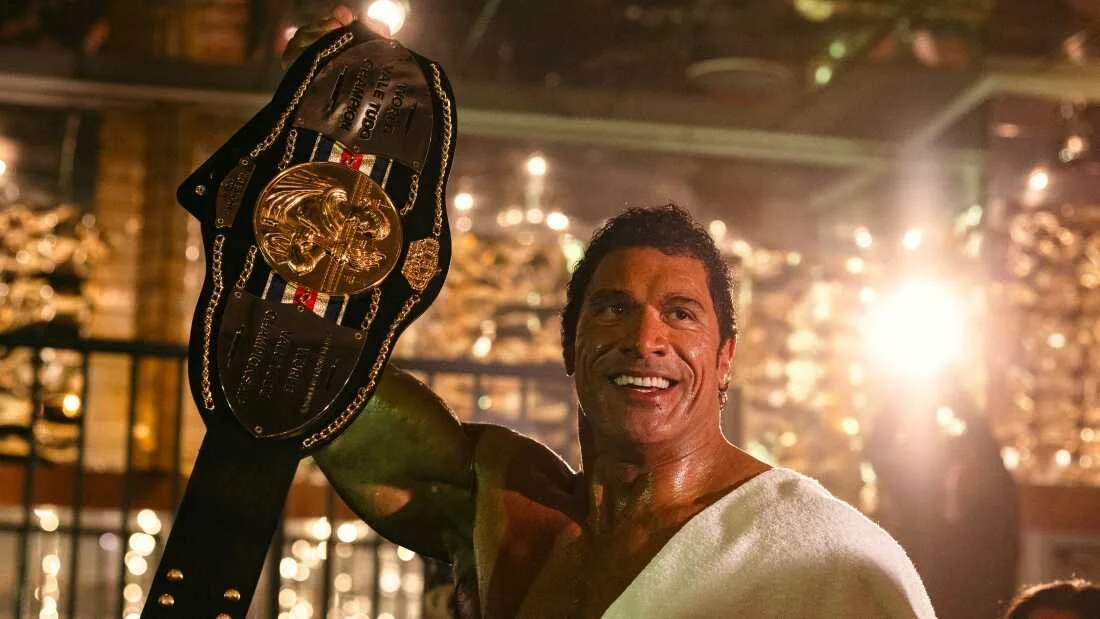The Smashing Machine Review
You can’t win forever. Eventually, either you lose or you die. Professional sports demonstrate the cruel extreme of this principle. Most of us have more than 60 years to do what we want to achieve, but for athletes, everything speeds up. Many athletes peak at 20, and by the time they’re 30 they’re on the professional off-ramp. The body betrays the spirit.
The Smashing Machine (2025) is not the first film about the career of real life MMA fighter Mark Kerr. The 2002 documentary The Smashing Machine: The Life and Times of Extreme Fighter Mark Kerr covers much of the same ground, spanning the same chunk of Mark Kerr’s professional fighting career. The Smashing Machine (2025) even looks like a documentary, largely shot on handheld in cinema vérité style. Which begs the question—if The Smashing Machine is going to look like a documentary and tell the same story as an existing documentary, why make it at all?
The answer, of course, is because of the Rock. Dwayne Johnson’s own past as a wrestler invites us to compare Kerr and Johnson. In The Smashing Machine, we meet Kerr when he’s at the top of the mountain, an undisputed champion in his sport, and the story follows his slow descent from the peak. If you want, you can roughly map the trajectory of the Rock’s career onto the film’s narrative. Dwayne Johnson has slipped from a surefire box office bet to something more uncertain. With Black Adam, he failed to change the hierarchy of power in the DC Cinematic Universe. Some of Johnson’s more recent four-quadrant targeted action-comedies have sunk with barely a cultural ripple. Does anyone talk about Red One?
As a star vehicle, The Smashing Machine contains an inherent contradiction: we must see Dwayne Johnson transform, but must also always be aware that we’re watching Dwayne Johnson. In the film, Johnson sports prosthetics designed to make him look more like Kerr. The success level of this facial transformation varies from scene to scene—sometimes it works, and sometimes Johnson looks like a spray tanned Grimace. Toward the end of the film, Johnson dramatically shaves his hair and re-emerges with a freshly bald head and toothy smile, his real life persona pushing out from underneath the veil of character. The moment provoked laughter and applause from the audience at my screening.
The Smashing Machine repeats the same image over and over: Dwayne Johnson shot from behind, head bowed in effort, his back transformed into almost an abstraction of the human body, with muscles like the topographic map of a mountain range. The visual emphasis is often on the physical effort it takes to exist as Mark Kerr.
The film has surprisingly little to say about violence or combat sports, given that it documents the early years of competitive mixed martial arts. The fights are strangely the most tedious parts of the movie. The film grain, the beautiful quality of the light, and the thoughtful compositions contribute to a relentless tastefulness that obscures the physical reality of a fight. Every match is shot from behind the spectator side of the ropes, creating an artificial distance between us and the violence. This distance feels incongruous with the intimacy of the other sections of The Smashing Machine. We’re right there with Mark Kerr as he shoots drugs or argues with his girlfriend, but then the violence comes, and suddenly we’re held at arms length.
If you want to learn something about brutality and combat sports culture, watch an actual UFC match. It’s an authentically ugly, jarring experience to see people bash each other’s heads on the ground until blood splatters everywhere and the commentators scream like hyenas. All of this plays out under bright white floodlights, while sponsorships for beer or protein snacks crawl across the screen.
A couple choices in The Smashing Machine are so obvious they border on satire, like the training montage set to Frank Sinatra’s “My Way”, or the running kintsugi metaphor. If these choices were in fact meant to be satirical, they don’t come off that way in a film that for the most part plays earnestly.
For what it’s worth, the Rock does, in fact, give a great performance. He shuffles like a man whose body has genuinely taken a lot of savage beatings. Whenever a journalist or an everyday person asks Kerr to talk about his passion for MMA, Johnson slips into an oddly endearing soft-spoken salesman patter.
The most energetic stuff in The Smashing Machine is the dynamic between Mark Kerr and his girlfriend Dawn, played by Emily Blunt. Here, we’re not just seeing a somewhat generic tale of pain, gain and loss. Whenever Kerr is around Dawn, Johnson turns himself into a big baby, threading a childish neediness into his line deliveries. Kerr needs control and external approval, but he can’t quite admit this to himself. His neuroses drive him to needle Dawn, who in turn becomes insecure and lashes out in increasingly hurtful ways. Kerr and Dawn love each other but they’re also terrible for each other. It’s a real, textured relationship, and Johnson and Blunt sell the chemistry.
The movie ends with a small scene of the real Mark Kerr shopping at a grocery store, seemingly at peace. The text onscreen tells us that not too long after the events of the film, Kerr retired and started a family. He lost, but life went on.
If you enjoyed this article, please consider becoming a patron of Hyperreal Film Journal for as low as $3 a month!




Megan Mayumi is an actor and writer based in Austin. Letterboxd here: https://letterboxd.com/megmayumi/